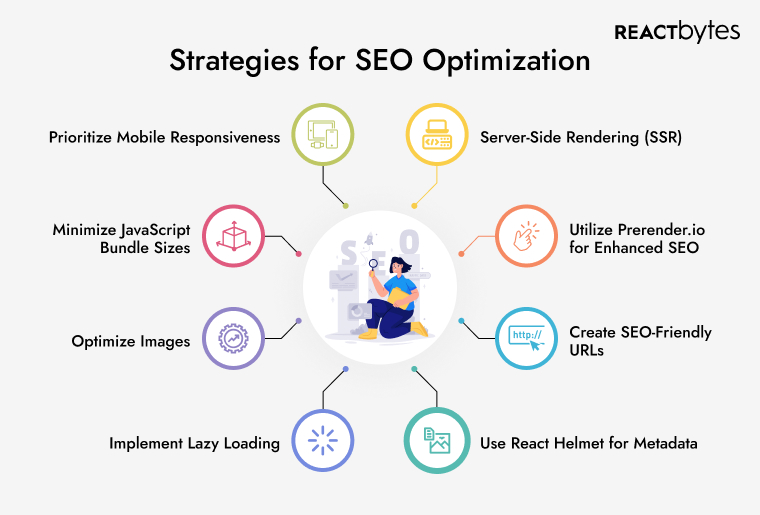In the ever-evolving world of web development, React.js has emerged as a popular choice for building dynamic and interactive web applications. Its component-based architecture and exceptional performance have won the hearts of developers.
However, there’s one aspect where React apps often face challenges: SEO, or Search Engine Optimization.
In this blog, we’ll explore the intersection of React.js and SEO, and provide you with clear and practical strategies to optimize your React app for better search engine visibility.
The SEO Challenge
1. Why SEO Matters
Before we delve into the specifics, let’s first understand why SEO is crucial. Search engines like Google are the primary gateways to the vast internet.
Your website’s visibility on search engine results pages (SERPs) directly impacts the traffic, user engagement, and ultimately, your online success.
With billions of websites competing for attention, ensuring your React app ranks well on search engines is imperative.
2. React’s Initial SEO Hurdles
React is known for its ability to create interactive and engaging user interfaces, but this very feature presents a challenge for search engines.
Traditional search engine bots have difficulty crawling and indexing content rendered using JavaScript, which React heavily relies on. This can result in poor search engine rankings and limited discoverability.
Strategies for SEO Optimization
Now that we understand the SEO challenge, let’s explore strategies to optimize your React app for search engines.

1. Server-Side Rendering (SSR)
Server-Side Rendering is a game-changer when it comes to React and SEO. It allows you to render React components on the server and send fully-formed HTML to the browser.
This makes your content accessible to search engine bots right from the initial page load, significantly improving SEO.
2. Utilize Prerender.io for Enhanced SEO
Prerender.io is a powerful tool for addressing React’s SEO challenges. It serves as a middleware that pre-renders your JavaScript-powered web pages on the server, providing a static HTML snapshot to search engine crawlers.
This approach ensures that your content is readily accessible to search engine bots, significantly improving SEO. Prerender.io is especially valuable for single-page applications (SPAs) like those built with React, as it bridges the gap between dynamic user experiences and search engine visibility.
Including Prerender.io in your SEO strategy can be a game-changer, helping you maintain the flexibility and interactivity of your React app while ensuring strong search engine rankings.
By incorporating Prerender.io into your SEO optimization toolkit, you’ll be better equipped to tackle React’s SEO challenges head-on and improve your app’s search engine visibility. This, in turn, can lead to increased traffic, better user engagement, and a more successful online presence.
3. Create SEO-Friendly URLs
The structure of your URLs plays a significant role in SEO. Ensure your React app’s URLs are descriptive, concise, and contain relevant keywords.
A well-structured URL not only helps search engines understand your content but also provides a better user experience.
4. Use React Helmet for Metadata
React Helmet is a popular library for managing your app’s document head. You can dynamically set the title, meta descriptions, and other essential meta tags for each page.
This allows you to optimize on-page SEO by tailoring these tags for specific content.
5. Implement Lazy Loading
Lazy loading is a technique that defers the loading of non-essential resources until they are needed.
This not only improves the page’s performance but also ensures that search engines can quickly index your content without getting bogged down by excessive JavaScript.
6. Optimize Images
Large, unoptimized images can slow down your React app and hinder SEO. Compress and resize images to ensure fast page load times. Use descriptive alt tags for images to enhance accessibility and SEO.
7. Minimize JavaScript Bundle Sizes
Large JavaScript bundles can deter search engines and frustrate users with slower loading times. Employ code-splitting and bundle optimization techniques to keep your JavaScript as lean as possible.
8. Prioritize Mobile Responsiveness
Mobile-friendliness is a key factor in SEO ranking, and React makes it relatively easy to create responsive designs. Ensure your app looks and performs well on various mobile devices.
Monitoring and Analysis
Optimizing your React app for SEO is an ongoing process. Regularly monitor your app’s performance and search engine rankings.
Tools like Google Search Console and Google Analytics can provide valuable insights into how your website is performing in terms of SEO.
1. Google Search Console
Google Search Console helps you track how Googlebot sees your site. It provides information about indexing issues, mobile usability, and search queries that bring users to your site.
Regularly check for errors and issues in the Search Console and take corrective actions.
2. Google Analytics
Google Analytics allows you to analyze user behavior on your website. You can track traffic sources, user demographics, and other valuable data.
This information can help you make informed decisions to further improve your React app’s SEO.
SEO Best Practices beyond React
While optimizing your React app for SEO is crucial, don’t forget about general SEO best practices. Here are some additional tips that apply to all websites:
1. High-Quality Content
Content is king in the world of SEO. Create valuable, unique, and informative content that caters to your target audience. Regularly update your content to stay relevant.
2. Backlinks
Backlinks from reputable websites can significantly boost your SEO. Focus on building a healthy backlink profile by engaging in guest posting, influencer outreach, and content marketing.
3. Page Speed
A fast-loading website is a critical ranking factor. Compress images, leverage browser caching, and use Content Delivery Networks (CDNs) to enhance your site’s performance.
4. Secure Your Site
HTTPS is now a ranking signal for Google. Ensure your React app uses a secure connection to protect user data and improve SEO.
Transform Your Vision into Reality with Our ReactJS Experts!

Conclusion
React.js is an exceptional tool for building modern web applications, but addressing its SEO challenges is essential for ensuring your content reaches a wider audience.
By implementing the strategies and best practices discussed in this blog, you can successfully optimize your React app for better search engine visibility. Remember, SEO is an ongoing process, so keep monitoring, analyzing, and refining your approach to stay at the forefront of search engine rankings.
